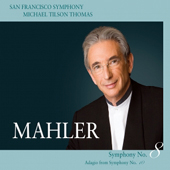
ESSENTIAL RECORDINGS

SFS Media SACD Hybrid SFS60021
This final chapter in the San Francisco Symphony Orchestra's ongoing saga of the complete Gustav Mahler symphonies, which began eight years
ago, brings to us the Symphony No. 8 in E-flat major, (Symphony of a Thousand). The stunning photograph inside the CD booklet gives us an
idea as to why it goes by that name. Also included, is a recording of the Adagio from Symphony No. 10, the last completed symphonic fragment
by Mahler.
The CD opens with the Adagio. A harmonically forward looking work, breaking new ground with adventurous leaps of the imagination. It's
unfortunate that we are not given the complete symphony, but some conductors prefer to stick to the one movement that Mahler had fully
noted and orchestrated before he died. Michael Tilson Thomas definitely sees this work as a 20th century creation, turning its back on
tradition and taking a bold step forward. Under this conductor's view, the new harmonic leaps and unusual intervals seem more modern
than most conductor's would have you believe.
The first few opening bars, scored only for the violas, that whole opening sequence is a question. It is Mahler asking a profound question.
The violas are probing in the darkness, tentatively seeking an answer, seeking the light, searching for a key. The orchestra answers,
at first quietly and innocently. But the violas never seem satisfied with the answer and keep repeating the question, prompting the
orchestra to respond more and more aggressively. Then, near the middle of the movement, the violas again as the question, this time with
more impatience, and this time actually add a note one semitone up to their question at the 19:08 mark. The orchestra does not like the
violas impudence and bears down on them with full force, suffocating the music with its dissonance, and emphatically warns them to stop
seeking answers to the riddles of life. By this time the harmonic fabric of the music has become very dense and complex, but gradually,
everything calms down and the music slowly seems to decompose itself and becomes simpler and simpler, reverting backwards harmonically
to the simplest structure possible. And that is when the light appears. That is when the answer to the question is finally revealed.
At 26:42, a massive, glorious chord is brilliantly laid out, ever so gently, layer by layer, until we hear the infinity of the universe
within it, and the music can now finally come to a peaceful resolution. Another Coup de Génie by Gustav Mahler.
All of the above is perfectly in evidence and then some, under the firm control of Michael Tilson Thomas and delivered with demonstration
class sound.
Symphony No. 8 tips the scales at the other end of the spectrum. It is a work bursting with energy, full of light and joy. As I have
mentioned before, it is miraculous how so few notes on a piece of paper, when well organized, can climb such emotional heights. The
forces involved in this creation are enormous. A full, enlarged orchestra, a pipe organ, eight singers, a boys choir, a girls choir,
and a full mixed choir.
In this recording the sopranos are Laura Claycomb, Elza van den Heever, Erin Wall, the mezzo-sopranos are Katarina Karnéus, Yvonne Naef,
the tenor is Anthony Dean Griffey and the baritone and bass-baritone are Quinn Kelsey and James Morris. They are surrounded by the San
Francisco Symphony Chorus, the Pacific Boychoir and San Francisco Girls Chorus. Everyone involved in this project sings with gusto, élan
and a sense of excitement and circumstance. The sopranos in particular soar high and clear over the ocean of sounds put forth by all
the tremendous forces involved. The first section of the symphony, the Veni Creator Spiritus leaps out at you, and
never lets up in energy, joy and sense of occasion. From the first organ pedal note to the final full choral walls of sound, this
performance never lets up. Michael Tilson Thomas knows that the creator of this work is also the best orchestrator, and balances
everything so well that the orchestra and choirs become one, with each and every individual parts, in all of their glorious counterpoint
and interactions, merge perfectly together to form one entity. All the intricate details are so well captured that they mysteriously
become invisible within the grand sheme of things.
The second half of this work, the Final Scene from Goethe's Faust begins quietly, with one of Mahler's most inspired
orchestral passages, and after a while the choir mysteriously joins in to create some amazing textural moments of brilliant harmony.
Very gradually the text unfolds and singer after singer join in representing different celestial characters, with the movement slowly
unfolding to become an orgy of uplifting and stupendous sound carrying us aloft.
The recorded sound here is simply amazing. Too often this symphony has suffered from poor recordings that would just simply crumble
under its weight, and sound terribly congested and turn to mush at all the crucial moments. Not this recording. Even in the most
powerful and maximum tuttis, the sound is clear, bright, full and round, and will thrill musicians and audiophiles alike. A supreme
achievement on all counts. Congratulations to all involved and sincere gratitude to Michael Tilson Thomas for making this Symphony of
a Thousand a crowning capstone to a distinguished and world class Mahler symphony cycle.
Addendum At the January 31/2010 Grammy Awards ceremonies, this recording performed a hat trick by winning 3 of
the main categories. It received awards for Best Classical Album, Best Engineered Album and Best Choral Album. It definitely deserves them all, and
over time more awards will certainly gravitate to it.
Jean-Yves Duperron